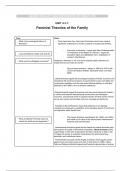Other
AL Sociology - Feminists on family revision notes
- Course
- Institution
These are incredibly detailed 7 page long summarisation on all you need to know about feminist theories of family. The revision notes containing dates, names and titles of key feminist thinkers and ideas on the family unit. It will ensure a comprehensive understanding of feminist views of the famil...
[Show more]



